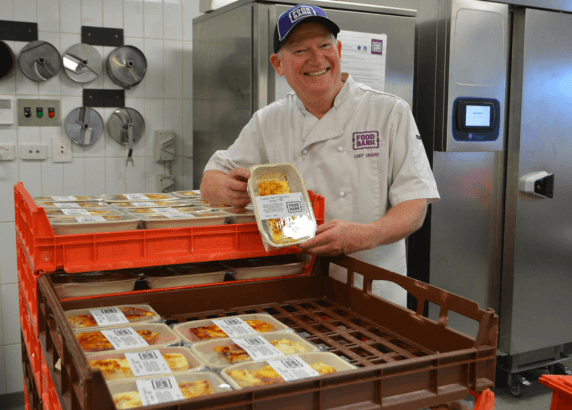The lifecycle of donated food
When you’re considering donating food, this is what happens to it
Chef Grant Longman has been the master of the mystery box challenge since the Community Kitchen opened in mid-2015.
Grant is no ordinary chef, he works primarily with produce donated to Foodbank WA, meaning he gives a second life to food that we rescue which would otherwise end up in landfill. To date, he has managed to help reduce our waste from 11% to 4% through the Community Kitchen.
Each week, the first port of call is the determine how many volunteers he will have in his kitchen, and typically aims to coordinate teams of up to six volunteers daily and together they prepare, cook and package, on average, 1,500 meals in a week.
Grant’s job isn’t easy but it is certainly creative, and he has to think outside the box each week when deciding on what to cook.
His process will usually start on a Thursday, when he chooses the most important element of his dish, the protein.

He’ll see what is available and sources around 300kg of mince, sausages, beef or chicken before moving on to see what he has available in his dry store. This could be commercial or catering sized lots of fresh or dry pasta, potatoes, fresh or instant but again, around 300kg. The available starch, be it rice, potato or pasta definitely begins to set the tone for the dish, which is finished off with a sauce when they are available.
We have been quite lucky lately with donations from Lite and Easy and Hellofresh containing sauces which add an extra something special to the dishes, because for Grant the most important thing is that his dishes should taste great!
Vegetables are also a really important element of the creations as they not only make for a balanced meal but also add flavour and texture. Carrots are always available, but we are often lucky enough to receive some delicious and exotic looking mushrooms, broccoli or zucchini – it really does change from week to week.
When all of the elements of the dish are chosen, locked in and cooked, next comes the packaging. Grant is always looking for new and better options for packaging his meals and he is currently implementing new compostable packaging and in doing so is making the kitchen even more environmentally friendly.
Most meals are then frozen at the end of the week so that they are ready for distribution the following week through our six distribution centres located in Perth, Albany, Bunbury, Geraldton, Kalgoorlie and Peel.
In addition to our branches, we also provide meals to people in need through our Mobile Foodbank service which is now operating in 60 locations in Perth and regionally in partnership with local front-line charities in areas of high need.
To throw a small spanner in the works not all of the meals Grant produces can be frozen. Depending on what has been donated, Grant may need to take a different approach with packaging and distribution. For instance, if the items donated are all fresh and not suitable for freezing, or if the items do not defrost well, Grant can use our heat sealers, which were donated by Chevron, to gas flush the packaging and extend the storage life of fresh salads. Some of the popular new meals being offered to our customers include lamb kidney pate and prawn coleslaw – with rave reviews!
What is the best part of Grant’s job? No one meal is ever the same. The forever popular lasagne will always have a variation to the recipe, based on what Grant can source from our donations. This week’s lasagne has pork sausages in it, and last year we had a lasagne with a Mexican twist, black beans included.
What is always consistent in Grant’s meals? The great taste of simple, healthy and hearty flavours.
 Contact us
Contact us Log in
Log in